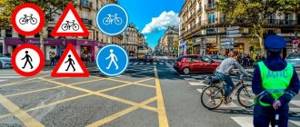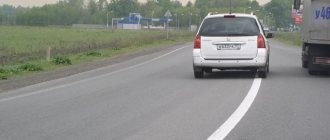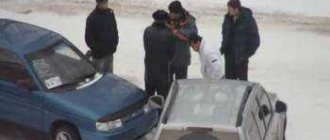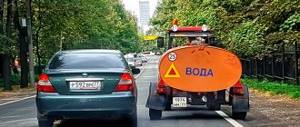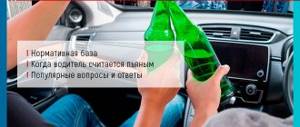The bicycle is becoming an increasingly popular mode of transport. It is relatively inexpensive, it does not require a driver’s license, there is no need to spend money on gasoline - this attracts people. But the reality of life is that cyclists have a hard time on busy roads. There are practically no separate lanes for them anywhere, so you have to drive along the narrow side of the road, where they can easily be hit by a careless driver.
What does a motorist face for hitting a cyclist? We'll talk about this in the article.
Feature of punishment
Based on traffic regulations, a collision with a cyclist often leads to serious consequences for the driver of the car. One of the reasons is that a two-wheeled non-motorized vehicle is not considered a high-risk vehicle. This means that in the event of a collision, the greatest attention will be paid to the actions of the person driving the car. Measures taken to avoid a collision are taken into account.
The features of a car (when compared with a bicycle) include:
- The ability to reach high speeds, which poses a danger to other road users.
- The dimensions of the vehicle are large enough so that it can be easily seen on the road.
- Before obtaining a license, the driver studies the traffic rules and passes an exam on the rules of the road.
In the case of a bicycle, the situation is the opposite:
- A two-wheeled vehicle is not capable of high speed.
- The bicycle and driver have limited dimensions, which complicates the visibility of such a vehicle on the road.
- The law does not stipulate the age at which a person has the right to drive. In most cases (when it comes to accidents involving a bicycle), a minor is driving.
“The case will simply be closed”
Traffic rules differentiate between the concepts of “driver” and “cyclist”. In judicial practice, according to lawyers, these concepts are also not identical. A cyclist is not a driver, and his two-wheeler is not subject to registration. Therefore, it is impossible to prosecute a cyclist for leaving the scene of an accident, said Orest Matsala, a leading lawyer at the European Legal Service. Unless the cyclist’s identity is established by the competent authorities and his movement on a bicycle is given a legal assessment.
Orest Matsala noted that there is another article - 12.29, which stipulates the responsibility of a pedestrian, passenger and other road user, including a cyclist. For example, he did not give way to someone or did not dismount in front of a pedestrian crossing. For this you will be fined 800 rubles.
If a biker interferes with the movement of other vehicles, he will be fined 1,000 rubles under Article 12.30.
They scratch the cars and drive away
Photo: RIA Novosti/Alexey Mayshev
According to Orest Matsala, without identifying the culprit, such a case will fall apart in two months.
It's rolling: the pandemic has spurred demand for bicycles
Two-wheeled transport has proven to be the best alternative to public transport during the coronavirus period
“An investigation will be conducted within a month, then it will be extended to two, and due to the impossibility of identifying the person, the case will simply be closed. There are statutes of limitations for bringing to administrative liability. In this case, the citizen will be forced to restore the car at his own expense. Unless, of course, he has a comprehensive insurance policy,” said the leading lawyer of the European Legal Service.
First actions in case of an accident
In the event of a collision between a car and a bicycle, almost all responsibility falls on the car owner. To avoid punishment or to reduce the level of responsibility, a person driving a car needs to take the following steps:
- We determine the condition of the cyclist. If there are injuries, the person must be taken to the nearest hospital. Before departure, it is important to limit the location of the accident and install an emergency sign. After delivering the person to the hospital, you must return to the place and call the traffic police.
- If there are no injuries as a result of the collision or the injuries do not require hospitalization, we call an ambulance and traffic police officers to the scene of the accident. It is prohibited to leave the scene or even move the vehicle.
- We turn on the hazard warning lights and put up a warning triangle (if this has not been done previously).
- We record the scene of the incident and take information from witnesses to the incident (if any).
- We are waiting for the traffic police to fill out the protocol. Here work is carried out to discuss the circumstances of the accident and the consequences of the collision.
If a collision with a cyclist occurred due to the latter’s fault, the damage is compensated only through a judicial authority. Due to the fact that the driver of a two-wheeled vehicle does not have compulsory motor insurance, one cannot count on receiving payments in any other way.
What to do after hitting a cyclist
Motorists should be more careful about the situation on the road between May and September. It is during this period of time that cyclists experience their most active season. Of course, you can see a bicycle on the road at any time of the year; some drivers even prefer to carry them with them even during the cold winter months, but it is during the warm season that the activity of lovers of this type of transport increases significantly.
The bicycle is gaining more and more popularity every year due to its mobility. Many city residents abandon cars in favor of such transport, even to get to their place of work. And, of course, cyclists prefer such a vehicle as sports equipment.
Since a bicycle is not a source of increased danger, in the event of a traffic accident, all responsibility rests with the driver of the car. To avoid a penalty or significantly reduce it, a motorist must take a number of actions:
- First of all, the motorist must determine the condition of the cyclist and, if necessary, take him to the nearest emergency room. But before leaving the scene of the accident, the driver must indicate the location of the accident using an emergency sign. Immediately after the victim is taken to a medical facility, the motorist must return to the scene of the accident and wait for the traffic police to arrive.
- If no one was injured as a result of the collision, or if the resulting injuries do not require urgent assistance from specialists, the driver must call an ambulance or traffic inspectors to the scene of the accident. You cannot leave the scene of an accident, nor can you move the car.
- Then the motorist must turn on the hazard lights and display an emergency stop sign for the vehicle.
- Before traffic police officers arrive at the scene of an accident, the motorist must record the scene of the accident, the position of the victim and the car relative to large stationary objects.
- Before traffic inspectors arrive at the scene of a traffic accident, the driver must obtain testimony from witnesses who saw the moment of the collision.
- After traffic police officers arrive at the scene of the accident, they will draw up a report. At this stage, you can begin to discuss the circumstances of the incident and the injuries sustained as a result of the collision.
In a situation where the bicycle driver was to blame for the accident, compensation for the damage caused is only possible through the court. Since the cyclist does not have a compulsory MTPL insurance policy (according to the law, this type of vehicle is not required to have this policy), it will not be possible to receive funds in any other way.
Collision at a pedestrian crossing
In some cases, a collision with a cyclist occurs at a pedestrian crossing. Here the rules of the road are clear. A cyclist must travel along a zebra crossing on foot, driving the vehicle in his hands. If a person complies with traffic regulations and finds himself under the wheels of a car, such an event is classified as a collision with a pedestrian. Here the legislation does not speak in favor of the car owner.
Another situation is possible when a cyclist crossed the roadway in the saddle of a bicycle. In this case, it was he who violated the traffic rules. But even under such circumstances, the driver is not relieved of responsibility. That is why it is important to be careful when driving through pedestrian crossings and to take into account possible violations by cyclists.
The most common collision cases
As we already know, cyclists are full participants in the road traffic, but at the same time the most vulnerable. According to official statistics, more than 90% of accidents involving cyclists result in injuries to the latter. However, most of the cases occur through no fault of their own. The average mortality rate for such incidents is approximately 5%.
If you look at the situation as a whole, we can note the following cases in which a car collides with a cyclist:
- Hit from behind.
- A bicycle rides out towards a car.
- Collision at a stop or traffic light.
- At a pedestrian crossing.
- In the courtyard.
Let's analyze each situation in more detail.
Collision with passing or oncoming traffic
Of course, by moving in the oncoming lane, a cyclist commits a gross violation of the rules, for which he faces not only administrative punishment. A motorist may simply not have time to react and run into a careless offender. Considering the speed and weight of the car, it is easy to predict the possible outcome of the situation. Therefore, you should not drive even near the curb in the oncoming lane. It's better to stop and carry the bike along the sidewalk.
But such rash actions, fortunately, do not happen so often. Much more often a situation may arise in which a cyclist suffers due to the driver’s carelessness. Let's assume that the latter is moving in its own lane, a car is driving behind, the driver of which presses on the gas, wanting to quickly pass the traffic light to yellow. In this case, the blame for what is happening lies only with the car owner.
When leaving the yard
It is not uncommon for a cyclist to be hit in the yard. The development of events can occur according to two scenarios. The first is when a car leaves the yard and a cyclist rides along the main road. Due to obstacles, a car driver may not notice a fast-moving bicycle and collide with it. In this situation, the driver of the car is to blame, since before leaving the alley on the road you need to slow down and look around carefully. A “mirror” case when a cyclist, leaving the yard onto the road, does not slow down. Although the cyclist’s guilt is obvious, even in this case it will not be easy for the car driver to fully justify himself.
Collision at a bus stop
The problem with this situation is that there are three traffic participants, each of whom does not violate the rules:
- a large trolleybus that has arrived at a stop and is disembarking/embarking passengers;
- a cyclist who, according to all the rules, makes a detour around an obstacle, moving slightly into the oncoming lane;
- a car moving in the oncoming lane, which does not expect that an inconspicuous vehicle will suddenly appear from behind the trolleybus.
In this situation, the cyclist finds himself between two cars. The culprit in this case will be the one who first violates the traffic rules.
At a pedestrian crossing
A situation in which a cyclist is hit at a pedestrian crossing also occurs in two cases.
The cyclist tried to quickly pass through the crossing, but the car did not have time to brake. This is one of the few cases when the law is on the side of the car owner. After all, the cyclist initially violated traffic rules while moving on the sidewalk.
A man drives a bicycle in his hands. Then the driver of the car is completely to blame, because in this case the cyclist is equal to an ordinary pedestrian. And the penalties for hitting a person at a pedestrian crossing are already more severe.
Collision on the roadway
Situations with road accidents on the roadway occur with enviable frequency. At the same time, the driver must realize that he bears the greatest responsibility. At the same time, a cyclist who enters the road also becomes a participant in the traffic. Therefore, it is subject to traffic regulations.
The rules specify the persons who have the right to travel on the roads:
- Persons aged 14 years and over can only travel along the side of the road, on special paths or on the right side. In the absence of the above options, moving on the sidewalk is allowed.
- Citizens under the age of 14 have the right to move only on sidewalks and pedestrian paths.
If the person driving the bicycle did not violate the traffic rules, the driver of the car is held accountable.
The driver hit a man
Cyclists and other road users are subject to traffic rules, just like motorists.
They are obliged to follow the rules and try not to interfere with other road users. Scooters and bicycles must have lighting devices, as well as a headlight, without which entry on public roads is prohibited. Naturally, not everyone remembers this requirement of the rules, but in vain. In this case, the risk of getting into an accident increases and the cyclist may even be found guilty of the accident.
If a cyclist or scooter driver is involved in an accident due to the driver’s fault, then the damage caused to him will be compensated by the insurance company under the OSAGO policy. If, in addition to the bicycle, a person was also injured, then he is also entitled to compensation for damage to health and moral damage.
Liability in case of an accident with a cyclist
In 9 out of 10 cases, the car owner who hits a cyclist tries to escape from the scene of the accident.
In this case, the driver of a two-wheeled vehicle must leave the roadway, leaving the vehicle in the same place. The best option is if immediately after the accident it is possible to record the data of the second participant. For these purposes, you can use a photo or video camera. Next, the collected information is transferred to the inspector, who will subsequently search for the violator with his colleagues. In the event of a collision with a cyclist, the driver faces liability, which depends on the level of harm caused. Taking into account the Code of Administrative Offences, the car owner is subject to administrative liability (fine) in the following cases:
- The collision resulted in a minor injury to the cyclist.
- The man driving the two-wheeler suffered minor injuries.
- As a result of the accident, the cyclist received serious injuries (for example, fractures), which are not life-threatening.
The greatest administrative punishment provided for by law involves deprivation of rights for a period of up to 2 years and a fine of up to 25,000 rubles. If the cyclist received more serious injuries, the driver faces criminal liability - prison for up to 2 years and deprivation of rights for up to 3 years.
As a rule, a criminal case is initiated if a cyclist dies or receives life-threatening injuries. Also, the likelihood of imprisonment is high in the event of fetal death (if the victim was pregnant), as well as in the event of amputation of any of the cyclist’s limbs due to an accident. In this case, the determination of the level of harm is carried out only by the doctor of the medical institution.
Look for cameras
Lawyer Alexey Gudas recommends obtaining testimony from witnesses and filming the surrounding area, so that later you can see if there are any surveillance cameras in the area, recordings from which could be used in court - if the cyclist contacts law enforcement agencies due to harm caused to health . This way it will be possible to prove that the cyclist left the scene of the accident.
They scratch the cars and drive away
Photo: IZVESTIA/Alexander Kazakov
“If the car is damaged - scratches, chips, cracks, you need to call a traffic police officer to document the damage. By the way, you can ask cars driving nearby for recordings from their DVRs,” advises Gudas.
Move around like an adult
What motorcycle enthusiasts and cyclists need to know
What statistics say about accidents involving cyclists
Currently, statistics are only available for 2021. It should be noted that in Russia there has been a general trend towards a decrease in the number of road accidents. However, against this background, the statistics of accidents involving cyclists is showing an increase. Accidents involving cyclists increased by 6.1% in 2021. From January to September last year, 4,606 cyclists were injured in road accidents (an increase of 4.0%).
A cyclist, even in special equipment, has very little protection in the event of an accident. Therefore, almost every incident involving them is accompanied by injuries of varying severity, and often leads to death.
Who is guilty
First of all, when an accident occurs, you need to identify the culprit. Especially when disagreements arise regarding damage and damage incurred.
The culprit due to inattention or neglect of other road users may be either the driver driving the car or the cyclist himself.
In order to determine the party at fault in an accident, you need to know the probable causes of the collision. Different perceptions of movement on the roadway can lead to unforeseen circumstances.
Please note! Common reasons are:
- unsafe turn of a traffic participant to the right;
- cycling on the sidewalk;
- lack of reflectors and lights;
- cycling a pedestrian crossing;
- unexpected maneuvers of the cyclist;
- The driver of the car does not give way at an intersection.
There may be other reasons, because it is not possible to predict everything. In addition, the causes of collisions due to the fault of a cyclist are often considered separately, and separately due to the fault of a motorist.
Registration of an accident
An accident involving a cyclist is processed in the same way as any other traffic accident. The first thing to do is to determine whether there are victims. If there are injured people, you need to call an ambulance and the traffic police, and also provide first aid if possible.
If there are no casualties, participants should proceed as follows:
- Turn on the emergency lights and display emergency stop signs.
- Call the traffic police service.
- Take photos that clearly show the location, vehicles, braking distance and damage caused.
- Collect contact information of all witnesses to the incident.
- Describe the incident in detail in the traffic police officer’s report.
Please note, if the location of vehicles interferes with traffic, you must record the accident in a photo or video, clear the roadway and wait for the traffic police on the side of the road.
Moving towards a car
All types of vehicles (including bicycles) have designated lanes on the roads. In our country, the right-hand traffic pattern has long been used.
Important! All categories of vehicles must comply with this requirement, be it a huge heavy dump truck or a small bicycle. Therefore, the case in which a cyclist moves in the oncoming lane against the flow of traffic is an incorrect and potentially dangerous situation.
The result of such a maneuver can be extremely negative, given the speed of transport on the road.
SIM commanded
A year ago, the Ministry of Transport proposed placing electric scooters, Segways and unicycles into a separate group - personal mobility devices. A number of responsibilities and instructions will be prescribed for their owners, and administrative liability will be introduced for traffic violations.
So far, drivers of such vehicles are treated like ordinary pedestrians. However, it is for pedestrians that electric vehicles pose the greatest danger, since they often move through pedestrian areas at high speeds.
They scratch the cars and drive away
Photo: IZVESTIA/Alexander Kazakov
If the proposal is approved by the authorities, 14-year-old SIM holders will only be able to travel on bike paths, bike lanes and roadways. Owners of mobile devices can ride together with pedestrians only in the absence of the above-mentioned areas for cyclists, and then at a speed no higher than 20 km/h.
Rolling on a scooter: Segways and unicycles can be equated to mopeds
What is a “personal mobility device” and where will it be allowed to live?

